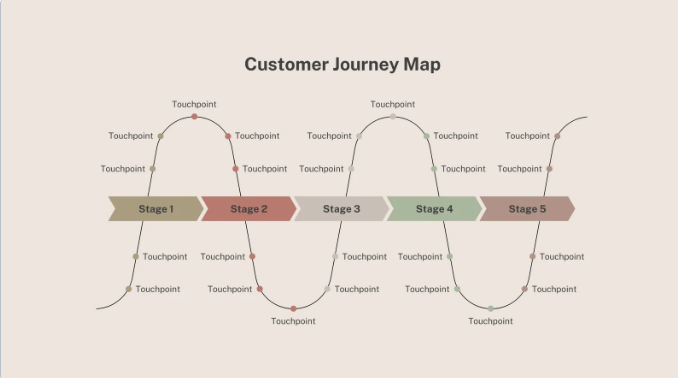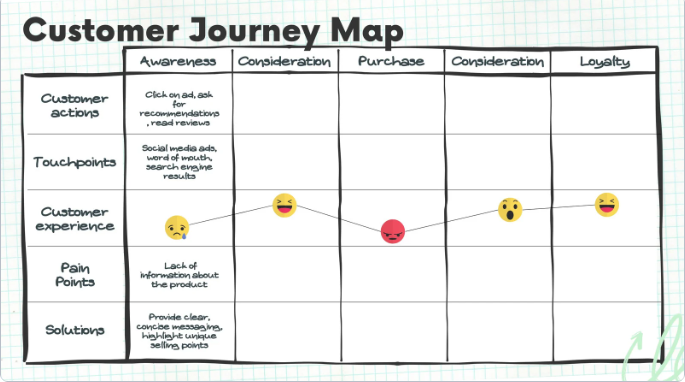The Perfect Customer Journey for Revenue Seeking E-commerce Companies

How do you direct the path of a total stranger who just discovered your e-commerce company on the internet and walk them through a path that will make them buy from you and love you enough to refer others to you?
It's called the E-commerce Customer Journey!
And it is what sets the e-commerce giants apart from the struggling contenders. For example…
It is the same path that Black Ember, an e-commerce company, used to successfully launch a new product, without being intrusive or forceful.
They crafted a seamless e-commerce customer journey map that helped them attract up to 4,019 new visitors to the product page, and attained a very high conversion rate of 29.4% in just 14 days of launch.
YouFoodz also used seamless customer journeys to grow their sales by 3,000% over the space of 14 months, even after losing so many customers to their competition.
Now, how exactly did these companies achieve this feat using a simple customer journey map and how can you do the same to get even better conversions and grow revenue for your business?
I’ll show you that in a moment...
But first, let me start by dissecting to you what an e-commerce customer journey is, why it is extremely important to your business success, and what makes the e-commerce customer journey map the most treasured weapon you can use to conquer your competition, multiply your sales and revenue, and grow your ecom business.
What is an E-commerce customer journey?
An E-commerce customer journey is the pathway a potential customer takes from the moment they become aware of your brand to the moment they purchase your product(s).
In simple terms, it is the step-by-step pathway a random person who knows nothing about your brand takes, from when they don’t know you, to where they know about your brand and then buy from you again and again. It starts from when a person clicks on your Ad or content… to browsing and considering whether your product meets their needs… to final purchase and checkout.

Why is the e-commerce customer journey important? Why should you border?
The ecommerce customer journey is extremely important to your business growth because every step is a crucial touchpoint that can make or break a sale.
Plus undisputable data has shown that it is the major key to attracting and retaining new customers, building customer loyalty, and influencing brand reputation.
Therefore it is safe to say that creating a seamless customer journey is like having a treasure map that helps you to consistently and predictably increase your sales and revenue.
Here are some key benefits of crafting a perfect customer journey for your e-commerce business:
- Improved Customer Experience: The customer journey helps you to visualize every touchpoint or interaction the customer has with your business, so you can easily identify their pain points, motivations, and desires… and use this information to personalize the customer experience.
By providing personalized experiences, you create a sense of familiarity and convenience that makes customers return and buy again.
- Higher Conversions and increased sales: if you craft a customer journey, you can identify your customers' pain points, motivations, and objections and easily address them at each stage. This reduces the friction the customer may experience in buying your product boosts the conversion rate and increases sales.
- Increased Brand Loyalty: In a survey, 73% of customers say an enjoyable customer experience is the number one reason they remain loyal to any brand. A seamless customer journey helps you to improve customer experience and ultimately increase brand loyalty. This means you can easily turn one-time customers into repeat customers who buy from you again and again.
- Revenue Growth: If you create a customer journey that moves customers seamlessly from one stage to another until they purchase, they experience less friction and this leads to more sales and more satisfied customers.
Satisfied customers (always) become repeat buyers and often refer their friends and family to your brand.
For example, OddBalls, a clothing e-commerce company integrated a perfect customer journey into their marketing strategy for a product launch. The result? They generated an extra £50k in revenue.
- Improve Brand Reputation: Your customer journey will shape the opinion customers have on your business regardless of whether they buy or not. If you make your customer journey smooth and seamless, customers will surely leave positive reviews and feedback, which will positively improve your reputation and lead to more sales.
- Reduce Cart Abandonment: Cart abandonment is one of the major causes of low sales for e-commerce businesses. But with a perfect customer journey, you can easily see the loopholes in your marketing strategy and identify the reasons customers abandon their orders. Then you can address these issues and streamline your checkout process to capture more sales from the abandoned carts.
- Increased Customer Lifetime Value (CLV): Having the perfect customer journey helps you visualize how much each customer has spent in your business and how you can make them spend more with you. Once you know this you can put in place measures that encourage customers to buy again and again, therefore increasing the CLV.
Now you’ve seen the importance of having a perfect e-commerce customer journey and how it can help you increase sales and grow revenue, the next question is how can you create the perfect customer journey for your business?
But first, you need to understand the different stages of the customer journey and how you can optimize each stage to build your perfect customer journey.
The Five Stages of an E-commerce Customer Journey

Every customer goes through five stages from the moment they discover your product to the moment they purchase.
Understanding and mapping each stage of the customer journey allows you to create a more personalized journey and experience for each customer.
The five stages of the customer journey are:
Awareness: This is the starting point of the customer journey. At this stage, a potential customer discovers your products/service and your brand either from online ads, social media content or from friends and family, etc.
To optimize the stage, you have to identify how customers find you so you can use the data to personalize subsequent stages of their journey until they buy.
Consideration: This stage is where potential customers start showing interest in your brand by browsing and evaluating your products or services to see whether it meet their needs.
To optimize this stage, you showcase your unique selling points. That is, show why your product is the best, by displaying its unique benefits, customer reviews, ratings and testimonials.
You also need to pay attention to the different products they browse at this stage. This is the customer telling you what she's interested in so you can give her a seamless journey to purchase.
Acquisition or Conversion: This is the stage a customer makes a purchase. This stage is crucial because it has the most direct effect on your conversion rates. And if this stage goes frictionless, they'll likely come back and purchase more.
The best way to optimize this stage is to provide easy payment and delivery options to ensure the purchase is successful. Also SHOW (don’t just tell) that their information is safe with you so that they'll feel safe to buy from you.
Retention: This is the stage where the customer buys again, mostly because they like your product and had a great experience the first time they bought your product.
To optimize this stage, create an amazing post-purchase experience. For example, provide fast response to queries and feedback, offer rewards, discounts, and loyalty points to encourage customers to purchase other products they're interested in, etc.
If you get this stage right, you should hit a high repeat purchase rate, customers will actively participate in loyalty programs and they'll refer their friends to you and this is good news for your business.
Advocacy: This is the holy grail of the customer journey where your customers go from merely satisfied customers to highly loyal brand advocates and actively recommend your products or services to their friends and family.
This is the most powerful form of marketing. It is based on word-of-mouth and referral traffic. It contributes a great deal to expanding your customer base.
If you get this stage right, you'll notice high referral rate and high influx of new customers. This will ultimately lead to exponential increase in your sales and revenue.
Now you know the 5 stages of an ecommerce customer journey, how can you optimize this to create the perfect ecommerce customer journey for your business?
How to build the perfect Customer Journey map for your E-commerce Business
Creating a seamless customer journey is essential for attracting and retaining new customers.
By designing a seamless, frictionless experience that meets customer needs at each stage of the journey, you can enhance engagement, drive sales, and foster long-term loyalty and business growth.
However, this is a continuous process because customer behavior changes all the time so you must keep up with these changes to get consistent results. Here's a proven step-by-step process of how you can create a seamless customer journey:
- Identify and Define your Ideal Customers: Understanding your customers is crucial for building a seamless customer journey map. Market research and customer data pave the way for success in this regard.
But don't just create a generic ideal customer profile. Take the extra time to build a highly detailed customer profile. Identify who your customers are, their age, gender, needs and wants, motivation, challenges, and what they expect from your product, etc.
How do you gather this treasure of information?
- Look into your current customer data (demographics, purchase history, browsing history, location, etc)
- Talk to existing customers for feedback and insights. You can also employ the use of surveys and interviews to collect feedback.
- Analyze your competitors' customer base.
- Employ social media insights to find out what they talk about, posts they like, etc.
- Look through customer service emails and feedback to look for the most asked questions and feedback.
- Create Customer personas and create segments for targeted approach: After you've identified your ideal customers, you go a step further to group them into segments. Yes, they're all interested in your products, but they still have different preferences that's why you have to further group them into segments.
Think of this as creating detailed character sketches for the different people who are your ideal customers. You do this by monitoring how customers interact with your business right from the initial point they came in contact with you, the products they browse, etc.
When you create these segments, you can visualize their needs and preferences and personalize their experience to create a seamless customer journey.
This step is very important because it could be the difference between making just a few sales a day to making a boatload of sales daily.
- Define your Goal: After you've segmented your audience, you want to clearly define your goal so you can visualize how to move your customers toward achieving this goal.
Although the overall goal is to increase sales, each segment will have different goals because they're at different stages in the customer journey. So you should define the goal for each segment to get a clear idea of the actions they need to take to reach that goal.
- Define your customer touchpoints: A touchpoint is an interaction between a customer and your business at each stage of their customer journey.
Understanding these touchpoints will help you create a more personalized customer journey. Customer touchpoints are:
- Social media, including ads and organic posts.
- Your marketing emails.
- Website features like product pages, checkout, customer reviews, etc.
- Peer referral and customer loyalty programs.
- List the actions you want your customers to take at each stage: Do you want them to go to the product page or website? Do you want them to make payments, or to see new products? Listing out these actions helps you to improve micro-engagement and create a seamless and personalized customer journey.
You can also reduce the friction customers experience when taking these actions in their journey.
For example, if a customer explores a product in your shop you send an email immediately to tell her what to do next.
- Craft your customer journey map: Once you've done steps 1 to 5, it's time to map out the entire journey from the customer’s perspective. This involves identifying all touchpoints, channels, and interactions a customer may have with your brand, from initial awareness to post-purchase support, and mapping it out on a sheet.
Mapping the customer journey helps you identify pain points, gaps, and areas of improvement so you can eliminate all guesswork in your marketing and get consistent results.
For example, Tesla, the electric vehicle manufacturer, always prioritizes a seamless customer journey. They map out their customer journey from researching vehicles on the website to configuring and ordering a car, to post-purchase services and support.
This customer journey is designed to be intuitive, effortless, and consistent across all touchpoints, so they attract new customers seeking a seamless car-buying experience. And this is a major reason why they are very successful.
- Craft Personalized and compelling emails for each stage: Now that you have mapped out your customer journey, it's time to craft the emails and content for each stage of the journey.
Every email or content you send at each stage is important to move your customers to the next stage.
Your emails should contain highly personalized content. The copy, images, and design should match your brand style.
- Choose and plan your resources: Now you have a clear picture of your customer journey map, choose the resources that will help you execute your e-commerce campaign and help customers complete their journey for a seamless customer experience.
Choose the best email automation tools, data tracking tools, and customer satisfaction tools that suit your business and will help you achieve your goal.
- Test, and launch your customer journey campaign: It's time to test your customer journey. From your test, you can see what works best for your audience and adjust your customer journey map.
And finally, you can launch your campaign. You still need to analyze your data, correct mistakes where necessary and improve results.
There, you have it. The step-by-step process you can use to create the perfect e-commerce customer journey that multiplies your sales and revenue for your business.
But also note that the e-commerce customer journey never ends, but evolves. Continuous testing, feedback analysis and regular adaptation will help you to align your strategies with the ever-changing needs of your customers to achieve lasting success.
In summary…
We've come a long way, you and I, from the beginning of this article.
I've shown you the important role customer journey plays in multiplying your revenue and growing your business. I've shown you the many benefits of having a seamless customer journey.
I've also shown you real-life case studies of how e-commerce companies have used customer journeys to increase their revenue. And I've shown you how to create the perfect customer journey for your business.
The important question now is what's the best way to start using the perfect customer journey in your business right away? You can go right ahead and follow the steps I showed you in the last section.
Still need help? Then you can employ an email marketing specialist to help you craft and implement the perfect customer journey for your business.
In conclusion, there will always be differences in sales results between two businesses because of many different factors. But any business who uses a seamless customer journey is bound to get much better results and higher revenue because…
At the end of the day, only the brands that understand this wins - “Customer journey is not an option; it is the only path forward.”
